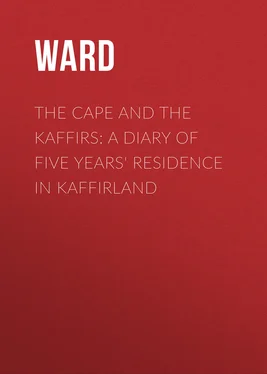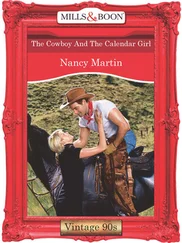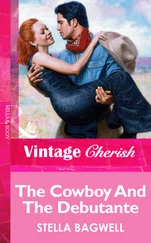Ward - The Cape and the Kaffirs - A Diary of Five Years' Residence in Kaffirland
Здесь есть возможность читать онлайн «Ward - The Cape and the Kaffirs - A Diary of Five Years' Residence in Kaffirland» — ознакомительный отрывок электронной книги совершенно бесплатно, а после прочтения отрывка купить полную версию. В некоторых случаях можно слушать аудио, скачать через торрент в формате fb2 и присутствует краткое содержание. Издательство: Иностранный паблик, Жанр: foreign_prose, История, foreign_edu, foreign_antique, на английском языке. Описание произведения, (предисловие) а так же отзывы посетителей доступны на портале библиотеки ЛибКат.
- Название:The Cape and the Kaffirs: A Diary of Five Years' Residence in Kaffirland
- Автор:
- Издательство:Иностранный паблик
- Жанр:
- Год:неизвестен
- ISBN:нет данных
- Рейтинг книги:4 / 5. Голосов: 1
-
Избранное:Добавить в избранное
- Отзывы:
-
Ваша оценка:
- 80
- 1
- 2
- 3
- 4
- 5
The Cape and the Kaffirs: A Diary of Five Years' Residence in Kaffirland: краткое содержание, описание и аннотация
Предлагаем к чтению аннотацию, описание, краткое содержание или предисловие (зависит от того, что написал сам автор книги «The Cape and the Kaffirs: A Diary of Five Years' Residence in Kaffirland»). Если вы не нашли необходимую информацию о книге — напишите в комментариях, мы постараемся отыскать её.
The Cape and the Kaffirs: A Diary of Five Years' Residence in Kaffirland — читать онлайн ознакомительный отрывок
Ниже представлен текст книги, разбитый по страницам. Система сохранения места последней прочитанной страницы, позволяет с удобством читать онлайн бесплатно книгу «The Cape and the Kaffirs: A Diary of Five Years' Residence in Kaffirland», без необходимости каждый раз заново искать на чём Вы остановились. Поставьте закладку, и сможете в любой момент перейти на страницу, на которой закончили чтение.
Интервал:
Закладка:
“This state of bondage at last became utterly intolerable, and its victims only looked for an opportunity to throw off the yoke. Their attention had been anxiously turned towards the colony, and communications had been made to the frontier authorities long before the irruption in 1834, urgently praying for an asylum within our boundary: but this application was kept a profound secret, from a conviction that were their intentions known to the Kaffirs, the indiscriminate massacre of the poor Fingoes would be the consequence.”
The war, of which many histories are given, delivered these poor creatures from their bondage, and they are now a happy people, with their own independent possessions of cattle, Sir James Alexander supplies an interesting description of their deliverance from captivity.
They are a fine muscular race, bearing a great resemblance to the Kaffirs, yet easily distinguishable from them: unlike the Kaffirs, they are a cheerful race. The moonlight nights seem their seasons of festivity; and their wild chant, now rising loud and shrill, from the huts opposite Fort Peddie, and now felling into a low muttered chorus, now led by a single voice, and again sinking into indistinctness, has a singular effect on civilised ears, not the less extraordinary from its being sometimes united with a running accompaniment of wolves howling about the cattle-kraals, and dogs yelling after them. At such times, the wild chorus generally ceases, lights are carried to and fro in the kraal 7 7 The word “kraal” applies either to the group of huts forming a village, to a single hut, or the fold for the cattle.
, or hamlet, and there is a sound of a hunt, such as one might fancy would be ably illustrated by Retzsch’s wondrous pencil. After successive shouts from the Fingoes, and yells from the dogs, the yelp of the wolf is heard further off, and changes to a smothered whine, till it ceases altogether. The dogs continue barking for some time, the torches are extinguished, and, as all again becomes quiet, the strange chant recommences. Sometimes the noise of clapping of hands, resembling, from the distance at which it is heard, the sound of the tom-tom, or rude drum, may be distinguished, marking time probably to the steps of the untiring dancers, for their revelry generally lasts till morning’s dawn.
Neither Fingoes nor Kaffirs seem to take much note of time: they sing and dance when they are merry, sleep when fatigued, eat and drink when hungry and thirsty. Days, weeks, months, and years pass by unnoticed, and uncounted. If in want of comforts which must be purchased, they work to earn money; if well provided, they will do nothing. In cold weather, they will not leave their huts even to milk their cows.
One of the most interesting anecdotes I have heard, was told me one day, relative to a Fingo man, tallying well with the scene I have alluded to of the group reading the Bible under the shade of the mimosa-bush. A poor Fingo had made several applications, from Graham’s Town, to a missionary nearly fifty miles off, for a Bible; but for some time there had not been a sufficient number printed to meet the devout wishes of those “who would become Christians.” Two years elapsed from the time this man first asked for the Bible. At last one day, he suddenly appeared at the station, and asked the missionary for one. The latter replied, that he was afraid he yet had none to spare; “but,” said he to the Fingo, “if you will do what business you may have on hand in the neighbourhood, and come to me before you leave it, I will endeavour to procure you one, if such a thing is to be had;” but the poor traveller surprised the missionary when he said he had no business to transact there, save the one thing which had brought him so far. He had come all the way from Graham’s Town, on foot, for the Bible; he would wait till one was found, or even printed for him. So the missionary was constrained to seek for one immediately, which he succeeded in obtaining; and the Fingo then offering 2 shillings 6 pence (the price of the book being 1 shilling 6 pence), the missionary offered the 1 shilling in change, but the traveller waited not. With the precious book which had cost him so much toil to obtain, in one hand, and his knob-kiurrie (war-club) in the other, away he trudged, light of foot, and certainly light of heart. He evidently considered his prize as more to be “desired than gold, yea than fine gold.” Such instances of sincere conversion are very rare.
There seems little doubt that Barrow’s idea of the origin of the Kaffir tribes in this country is a just one. He imagines them to be the descendants of those Arabs known to us by the name Bedouin. “These people” says he, “penetrated into every part of Africa. Colonies of them have found their way into the islands of Southern Africa, where more difficulties would occur than in an overland journey to the Cape of Good Hope. By skirting the Red Sea, and turning to the southward, the great desert of sand, which divides Africa into two parts, would be avoided, and the passage lies over a country inhabited, as far as is known, in every part.” The circumstance of their having short hair, would seem to militate against their Arabic origin; but their intermixture with the Hottentots and other nations along the coast may have produced this. Barrow adds, “Their skill in music is not above the level of the Hottentots.”
The latter have a most perfect ear for music, and cannot resist dancing and chorussing to a tune that pleases them. I have never heard the Kaffirs evince any disposition to sing, unless I except the monotonous drawl which the women utter for the men to dance to. Of the Fingo evensong, I shall have occasion to speak by and by.
It is already well-known that the Bosjemen and Hottentots are the aborigines of the whole of this part of South Africa. As one great proof of this, we find the names of the rivers are in the Hottentot language, between which and the Kaffir there is no affinity. It may, by the bye, be observed, that the Bosjeman and Kaffir languages have one thing in common,—a singular click, varying in its sound according to the letter pronounced: thus, C, T, R, and Q, appear to be the letters uttered in clicks—T is uttered between the teeth, like teh ; the R also resembles T in its pronunciation; Q is produced by a click nearer the front of the teeth than is requisite for the pronunciation of the C, which in its turn resembles the noise made in imitation of drawing a cork, and when two Kaffirs, Fingoes, or Bushmen, are conversing together on any subject that excites them to unusual rapidity of speech or gesticulation, the effect is extraordinary.
I desire not to lengthen my work with long quotations from other writers, though to do so with that experience which a residence in the country must give, would be to compile a useful and entertaining chapter; but by here and there comparing what I see of these wild people with what I have read, much may be gathered together that will throw a light on matters connected with them in their present domestic state, if such a term may be applied to a who are not yet tamed, and who, I doubt, never will be so. Like the lion, the tiger, the panther, and all the roaming tenants of the bush, the mountain, or the kloof, the Kaffir has become identified with the country to which he now belongs; and, though here and there one or two may be brought to understand the meaning of good principle, as a body, the Kaffirs will fulfil the destiny of their great progenitor, Ishmael, of whom it has been decreed by God, that his descendants shall “have their hands against every man, and every man’s hand against them.” Even though a man be brought up among Christians from his youth, and accustomed to his dress by day, and his bed by night, in manhood he will most joyfully return to his kraal, his kaross, and his mat. The daughter of Cobus Congo (Konky) is a striking instance of this. Educated in the house of an excellent missionary, taught the value of principle, Konky is now married to a chief who has many other wives; she wears the kaross, and rides an unsaddled horse, after the same fashion as her husband and his cortège. If, however, the missionaries fail generally in the one grand object of converting the Kaffirs and Fingoes to Christianity, many among them may be brought to some degree of civilisation. Already those who have been prevailed upon to learn to read (the difficulty lies in getting them to learn at all,) are diligent, and thirst for knowledge; as they progress in this, their communion with Europeans becomes more intimate, gradually they may acquire a wish to be clothed, and this may be of consequence to our manufactories. Already the English blanket, greased till it becomes the colour of ochre, begins to supersede the skin kaross; and the common brown coverlid is another favourite drapery of the Kaffir. A printing press is established at D’Urban (a missionary station near Fort Peddie); and, besides the translation of the Bible, a periodical is published monthly, containing articles suited to the taste, comprehension, and habits of the native.
Читать дальшеИнтервал:
Закладка:
Похожие книги на «The Cape and the Kaffirs: A Diary of Five Years' Residence in Kaffirland»
Представляем Вашему вниманию похожие книги на «The Cape and the Kaffirs: A Diary of Five Years' Residence in Kaffirland» списком для выбора. Мы отобрали схожую по названию и смыслу литературу в надежде предоставить читателям больше вариантов отыскать новые, интересные, ещё непрочитанные произведения.
Обсуждение, отзывы о книге «The Cape and the Kaffirs: A Diary of Five Years' Residence in Kaffirland» и просто собственные мнения читателей. Оставьте ваши комментарии, напишите, что Вы думаете о произведении, его смысле или главных героях. Укажите что конкретно понравилось, а что нет, и почему Вы так считаете.












